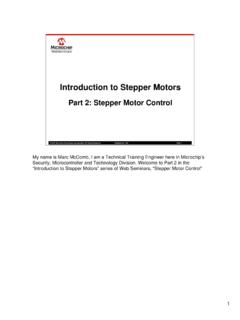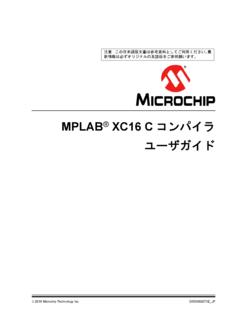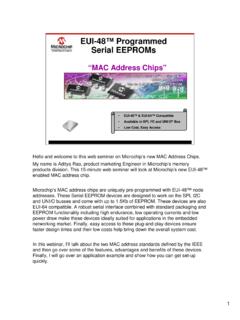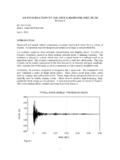Transcription of Introduction to SMPS Control Techniques
1 Page 1 2006 microchip technology Incorporated. All Rights Reserved. Introduction to smps Control Techniques Slide 1 Introduction to smps Control TechniquesWelcome to the Introduction to smps Control Techniques Web seminar. The following slides will introduce you to some of the basic Control methods that have been developed for use in smps designs have traditionally been implemented with analog pwmcontrollers. These controllers were built with comparators and op-amps and within their circuitry the Control algorithms were implemented; either Voltage mode or Current 2 2006 microchip technology Incorporated.
2 All Rights Reserved. Introduction to smps Control Techniques Slide 2 Session Agenda Voltage versus Current Mode Control Control Feed-Forward Techniques Digital smps Control Techniques Switching Methodology Control Loop StabilityThis is the agenda for this course. We will discuss the differences between voltage and current mode we will cover the PID Control Techniques and their application to digital Control systems are method and timing of the transistor switching and the associated effect on smps design is conclude this presentation by covering some major issues that relate to insuring stable Control 3 2006 microchip technology Incorporated.
3 All Rights Reserved. Introduction to smps Control Techniques Slide 3 Voltage Mode Control : The difference between the desired and actual output voltages (error) controls the voltageapplied across the inductor. Current Mode Control : The difference between the desired and actual output voltages (error) controls the peak inductor Analog smps Control TechniquesThe first approach developed to Control smps applications is called Voltage Mode . Voltage mode is intuitive, the actual output voltage is compared to the desired output voltage and the difference (error) is used to adjust the pwm duty cycle to Control the voltage across the , Current-Mode Control was developed to correct some issues known with voltage mode.
4 Current-mode uses the error between the desired and actual output voltages to Control the peak current through the 4 2006 microchip technology Incorporated. All Rights Reserved. Introduction to smps Control Techniques Slide 4 Voltage sensing is easier then current sensing: Less noise, Less power loss, Less cost, More resolution. Single feedback path is easier to Mode AdvantagesVoltage mode Control , where the output voltage is the Control endpoint, is conceptually easier to understand than current mode voltages is easy. Typically a resistor divider scales the output voltage to a value that is read by an ADC (Analog to Digital Converter), or is presented to an analog comparator.
5 The measured voltage levels are usually in the one to five volt range, so signal to noise ratios and resolution are not an voltage mode Control only needs to monitor the output voltage so only one feedback path is required, thus simplifying the design of the 5 2006 microchip technology Incorporated. All Rights Reserved. Introduction to smps Control Techniques Slide 5 Faster response due to single Pole system. Output capacitor is removed from feedback path. Responds immediately to input voltage changes. Inherent cycle by cycle current Mode AdvantagesCurrent mode (historically) has faster output response than voltage mode because the current in the inductor is controlled instead of the output voltage which is measured on the output capacitor.
6 Voltage mode is a two pole feedback loop while current mode is a one pole feedback loop. The single pole of a current mode Control loop requires less high frequency roll-off to maintain loop current responds directly with changes in input and output voltages. Current mode Control provides better response to input and output voltage variations because the current changes are sensed mode Control provides inherent current limiting on a cycle by cycle basis. Current limiting improves system reliability in response to current 6 2006 microchip technology Incorporated. All Rights Reserved.
7 Introduction to smps Control Techniques Slide 6 Control of Flux Imbalance is difficult. Fast response to load changes is difficult. Slow response to input voltage Mode DisadvantagesVoltage mode Control does not provide cycle by cycle Control of current thru the transistors, this lack makes transformer flux balancing more difficult (often requiring added components).The output voltage is measured on the output capacitor which makes quick detection of input voltage or output load changes two pole filter roll off in the feedback path further slows the system response to 7 2006 microchip technology Incorporated.
8 All Rights Reserved. Introduction to smps Control Techniques Slide 7 Control stability is more difficult with dutycycles > 50%. Requires slope compensation to prevent Sub-cycle oscillations. Wide input voltage variation is difficult to support. Low current loads difficult to Mode DisadvantagesCurrent mode Control requires two feedback paths, increasing the system complexity and cycles greater than 50% have problems with sub-cycle oscillations. To stop these oscillations requires the addition of Slope compensation . Slope compensation decreases the peak current limit as the duty cycle increases.
9 The reduction in peak currents is designed to maintain the same average currents with increasing duty accurate sensing of current is difficult to achieve with high accuracy. Typically, low ohmage resistors are inserted in the current path and the voltage drop across the resistor is an indication of the current. To minimize heat dissipation and voltage drops, the current sensing resistors are typically in the tens of milliohms range. The resultant voltage drops are in the millivolt range. Amplifying small signals in the presence of huge switching currents is a daunting input voltage range creates design issues because large variations in pwm duty cycle ratios are required, and exceeding 50% duty cycleintroduces issues with slope current loads that vary over large ranges are also difficult for current mode Control to handle because the light load results in very small current measurement signals.
10 The current measurement signals become buried in the 8 2006 microchip technology Incorporated. All Rights Reserved. Introduction to smps Control Techniques Slide 8 Classic Digital smps Control Proportional error, the Integral error, and the Derivative error of the actual output versus the desired output voltage are summed to Control the PWM technique may be used in Voltage Mode and Current Mode Control PID (Proportional Integral Derivative) Control algorithm was developed in 1942 by John G. Ziegler and Nathaniel B. Nichols. The PID loop is the dominant Control method for motor Control , industrial process Control , and plant controllers have been implemented in mechanical, pneumatic, and hydraulic systems, as well as in electronic form.

















